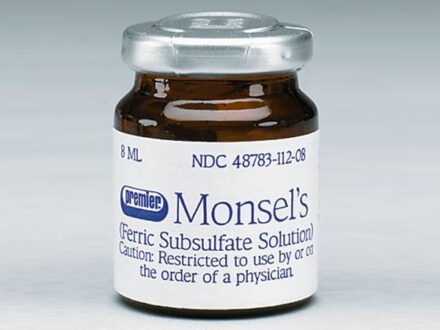Learn all about Monsel solution uses, side effects, mechanism, preparation. Monsel’s solution consists of 20% ferric subsulfate. It is used to produce hemostasis after biopsies of the skin and cervix. It is applied to the skin in the same manner as aluminum chloride. There is a small risk of tattooing the skin through iron deposition. One major nuisance in using Monsel’s solution is that the iron precipitates around the top of the container, making it difficult to open. Aluminum chloride containers are always easy to open.
Monsel’s solution can leave a histologic artifact in the skin. Therefore, when a repeat biopsy is performed in an area where Monsel’s solution was previously used, it helps to warn the pathologist.
Monsel’s solution has an acidic pH which is thought to contribute to its hemostatic properties eliciting protein precipitation in vessels and oxidization. Monsel’s solution is effective after punch or shave biopsies but is used less frequently due to its tattooing effect on the skin).
Solution can be applied with a cotton tipped applicator or gauze pad. Precipitates proteins intravascularly and oxidizes tissues. It is less expensive, more accessible, and easy to apply. Being used less due to intradermal ferruginous deposits causing tattooing of the skin after use
It should not be used in vesicular, bullous, or exudative (oozing) dermatoses because it may then cause permanent pigmentation on the skin. It may be harmful if swallowed and is for external use only. If swallowed, do not induce vomiting unless directed to do so my medical personnel. Never give anything by mouth to an unconscious person. Loosen tight clothing such as a collar, tie, belt or waistban
What is Monsel Solution?
Monsel solution is a reddish-brown aqueous solution of basic ferric sulfate, prepared from ferrous sulfate and nitric acid; used as an astringent and hemostatic. Monsel’s paste is a thick, sticky, fast-acting compound that is used to cover bleeding areas on the cervix to stem the flow of blood. It can be useful after cryotherapy, punch biopsy and loop electrosurgical excision procedure (LEEP).
Monsel Solution Uses
Monsel’s is an essential aqueous solution used during colposcopy and biopsy procedures. Ferric subsulfate solution is useful after small surgical procedures, such as a shave biopsy or a punch biopsy. A shave biopsy involves taking a razor or scalpel and cutting the tissue of the skin until the desired part is removed. A punch biopsy uses a circular blade to remove the preferred skin tissue. Each of these procedures takes about fifteen minutes, and as long as the wound is not too deep or large ferric subsulfate solution can be used to stop the bleeding. The incision site is then covered with gauze for protection. Ferric subsulfate solution can also be used after a cervical biopsy or colposcopy. Once the area of the cervix is cut, the solution is applied to stop the bleeding.
Monsel Solution Side Effects
Ferrugination of fibrin, dermal collagen, and striated muscle fibers may result from the application of Monsel’s solution (20% ferric subsulfate) for hemostasis to wounds caused by excisions of skin. The collagen fibers in the dermis are coated with a slightly refractile, gray-brown substance which is strongly positive with Perl’s reaction for iron. Ferruginated collagen fibers are eliminated through the epidermis as the epidermis regenerates. Some of the ferruginated fibers become calcified.
Monsel Solution Mechanism
Monsel solution Fe 4 (OH) 2 (SO 4 ) 5 is a brown fluid that is prepared by reacting ferric sulfate with sulfuric acid and nitric acid, and thus remains very acidic (pH approaching 1). Hemostasis as a result of Monsel solution is believed to be due to denaturation and agglutination of proteins such as fibrinogen by ferric ions, which is augmented by the low pH and subsulfate group. Uptake and tissue effects of Monsel solution have been studied extensively in the dermatologic and dermatopathology literature.
Monsel solution may lead to deposition of ferric salts (ie, ferrugination) within fibrin, dermal collagen, and striated muscle, which may cause refractory pigmentation of skin following its usage and an inflammatory reaction that may persist for weeks at the site of damage. When Monsel solution is used on epithelium after dermatologic biopsies there is often evidence of a “tattoo” effect with extended pigmentation of tissue. Ferrugination can also be seen with trauma from an iron-coated instrument. In muscle, ferrugination may cause damage and inflammation, but cross-striations are preserved and sometimes accentuated.
Monsel Solution Preparation
Monsel solution preparation is as under;
- Take care, as the reaction is exothermic (emits heat).
- Add a few grains of ferrous sulfate powder to 10 ml of sterile water in a glass beaker. Shake.
- Dissolve the ferric sulfate base in the solution by stirring with a glass stick. The solution should become crystal clear.
- Weigh the glycerol starch (see preparation instructions below) in a glass mortar. Mix well.
- Slowly add the ferric sulfate solution to the glycerol starch, constantly mixing to get a homogeneous mixture.
- Place in a 25-ml brown glass bottle.
 Health & Care Information
Health & Care Information 


